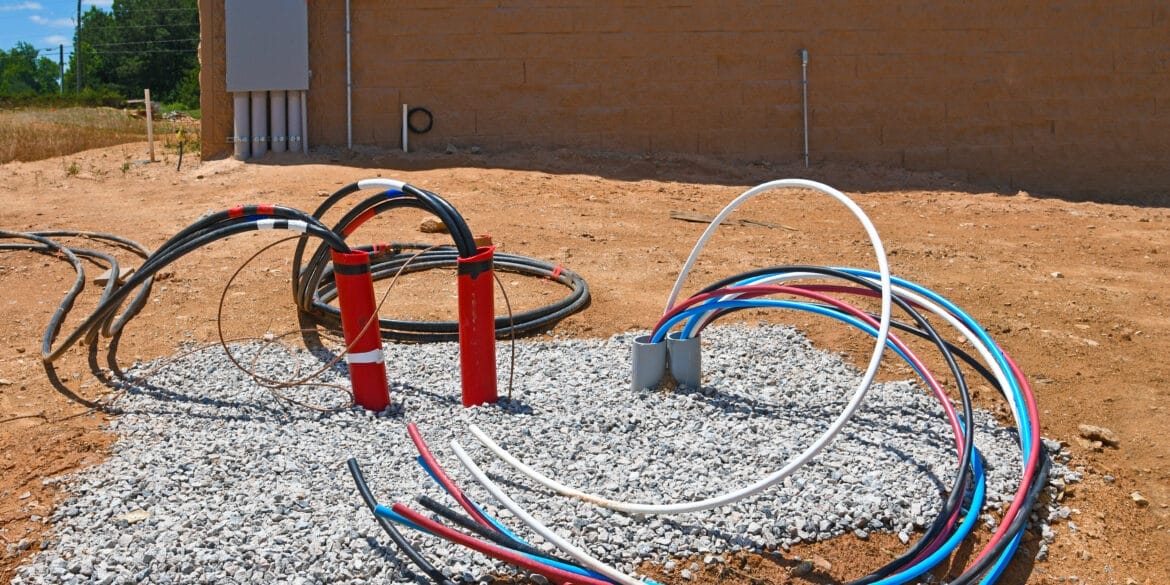Table of Contents
Overview of Cable Sizing Requirements
This comprehensive guide provides step-by-step instructions on how to size electrical cables according to Australian Standards, specifically AS/NZS 3008.1. Whether you’re an electrical engineer, contractor, or student, this resource will help you master the essential calculations for selecting the correct cable sizes in various applications. Key topics covered:
Current-carrying capacity calculations
Voltage drop requirements
Short-circuit performance
Neutral and earth cable sizing
We’ll walk through two detailed examples, demonstrating how to:
Calculate load currents
Select initial cable sizes
Determine cable operating temperatures
Check voltage drop compliance
Verify short-circuit performance
Choose appropriate active, neutral, and earth cable sizes
By following this guide, you’ll learn how to accurately size cables for different electrical installations while ensuring compliance with Australian Standards. Whether you’re working on residential, commercial, or industrial projects, these calculations are crucial for safe and efficient electrical systems.Use this article as your go-to reference for cable sizing calculations, and feel confident in your ability to design electrical systems that meet all necessary requirements and safety standards.
Example 1 - Three-Phase 400 V: Cable Sizing for High Current Load Over a Long Run
Three-phase 400 V system. Load current = 1200 A. Length of run = 260 m. The cable type is single core, copper, and XLPE 90 degrees. Buried in separate conduits. The voltage drop limit is 3.2 %. The fault level is 15 kA, and the clearing time is 1 second. Based on AS/NZS 3008.1, calculate the smallest active conductor, neutral, and earth cable sizes.
Step 1: Minimum size to meet current-carrying capacity
To determine the cable that could carry the 1200 A load, an initial cable size assumption would have to be made. A practical assumption would be to have 2 sets of 400 mm2 cables, which equates to 1252 A. From this assumption, we would proceed to the succeeding steps to determine whether this could provide sufficient current-carrying capacity, adequate voltage drop, and short-circuit performance.
The correct current rating table must be selected from AS/NZS 3008.1 based on the cable type and phases to make a valid assumption. Once the correct reference table has been identified, the correct column based on the installation method and conductor type must be selected.
The appropriate table and column for this problem is Table 8, Column 27.
Step 2: Minimum size to meet voltage drop requirement
\(I_R = 2460\ A\) (the value from Table 8 Column 27 is multiplied by 3, which is the number of runs chosen)
Determine cable operating temperature
Where:
\(\theta_A\) = ambient air or soil temperature, in degrees Celsius
The values for these are as follows:
\(\theta_A = 25°C\) (standard ambient temperature for soil)
From these, the calculated operating temperature is:
\(\theta_0 = 40.47°C\)
Determine cable resistance based on cable operating temperature
Determine cable reactance
The cable reactance \(X_c\) can also be determined from the cable type (XLPE)
Calculate voltage drop based on power factor and cable operating temperature
\(I = 1260\ A\) (Load Current)
\(L=260\, m\) (Length of the Cable)
\(\theta = 25.84°\)
\(V_{d3\phi} = 12.49\ V\)
\(\%VD = (12.49\ V/400\ V)*100\%\)
\(\%VD = 3.12\%\)
Step 3: Minimum size to handle the prospective short-circuit current
\(Z_t=\sqrt{R_c^2 + X_c^2}=0.0878\ \Omega/km\):
\(Z_n=400\ V/15000\ A=0.027\ \Omega\):
\(V_{\text{end}}=400\ V-12.49\ V=387.51\ V\):
\(I=\frac{V_{\text{end}}}{Z_{c} + Z_{n}}=\frac{387.51}{0.0228+0.027}\):
\(I=7829.78\ A\):
\(I^2 t = K^2 S^2\):
\(I=7829.78\ A\):
\(t=1s\):
\(K=168\):
Active Cable Size = 3 runs of 630 mm2
Step 4: Select the neutral cable size
Step 5: Select the earthing cable size
\(S=26.91 mm^2\)
Earth Cable Size = 500 mm2
Example 2 - 690 V Fire-Rated Cable Selection for 75 kW Load
The load is 75 kW, 3 phase, with a power factor of 0.9 at 690 V. The cable is Fire-Rated, Cu, single-core length = 5 m, unenclosed touching. There are no derating factors. The maximum allowed voltage drop is 2.5 %, fault level = 15 kA, and fault time (fault clearing time) = 0.15 s.
Step 1. Minimum size to meet current-carrying capacity
\(P=75000\ W\)
\(V=690\ V\)
Step 2: Minimum size to meet voltage drop requirement
Determine cable operating temperature
\(\left(\frac{I_0}{I_R}\right)^2 = \frac{\theta_0 – \theta_A}{\theta_R – \theta_A}\)
\(I_0=69.73\ A\)
Determine cable resistance based on cable operating temperature
Determine cable reactance
The \(R_c\) and \(X_c\) values will be used to calculate the voltage drop on the cables, considering the load dictated by the problem. Take note that these would need to be converted to Ω/m.
Calculate voltage drop based on power factor and cable operating temperature
\(V_{d3\phi} = IL\left[\sqrt{3}(R_c \cos \theta + X_c \sin \theta)\right]\)
\(V_{d3\phi} = 0.36\ V\)
\(\%VD = 0.05\%\)
Step 3: Minimum size to handle the prospective short-circuit current
\(t=0.15s\)
\(S=32.97 mm^2\)
Active Cable Size = 35 mm2
Step 4: Select the neutral cable size
Neutral Cable Size = 35 mm2
Step 5: Select the earthing cable size
However, the minimum earth cable size that can handle a phase-to-earth fault must also be checked. The equation for the minimum conductor cross-section used in Step 5 will also be used. The only difference is the phase-to-earth short circuit current will be used.
Earth Cable Size = 25 mm2
References:
[1] Electrical installations – Selection of cables – Cables for alternating voltages up to and including 0.6/1 kV – Typical Australian installation conditions (AS/NZS 3008.1.1:2017). Standards Australia and Standards New Zealand. (2017).
[2] Electrical installations (known as the Australian/New Zealand Wiring Rules) (AS/NZS 3000:2018). Standards Australia and Standards New Zealand. (2018).
![[AS/NZS 3008.1] Table 8. Current-carrying capacities. Three single-core cables
Table showing the current-carrying capacity of wires in various enclosures and conditions, including enclosed, thermal insulation, buried direct, and underground wiring.](https://eq8y3wpwe77.exactdn.com/wp-content/uploads/2024/11/image-20240826-021148.png?strip=all&lossy=1&ssl=1)
![[AS/NZS 3008.1] Table 34. a.c. Resistance (Rc) at 50 Hz
Table showing AC resistance ((R_c)) at 50 Hz for single-core cables in copper and aluminum, with conductor sizes and temperatures listed. 0.0389 in red rectangle indicates copper resistance for 60°C.](https://eq8y3wpwe77.exactdn.com/wp-content/uploads/2024/11/image-20240826-013217.png?strip=all&lossy=1&ssl=1)
![[AS/NZS 3008.1] Table 30. Reactance (Xc) at 50 Hz
Table displaying reactance values (Xc) at 50 Hz for various cable types and conductor sizes, highlighting a specific value, 0.0787, in a red box for single-core XLPE cables at 300 mm².](https://eq8y3wpwe77.exactdn.com/wp-content/uploads/2024/11/image-20240826-013415.png?strip=all&lossy=1&ssl=1)
![[AS/NZS 3008.1] Table 53. Temperature Limits for Insulating Materials in Contact with Conductors
Chart showing temperature limits for insulating materials in contact with conductors. Cross-linked polyolefin has a limit of 250°C as highlighted in the image.](https://eq8y3wpwe77.exactdn.com/wp-content/uploads/2024/11/image-20240812-024343.png?strip=all&lossy=1&ssl=1)
![[AS/NZS 3008.1] Table 52. Values of Constant K for Determination of Permissible Short-Circuit Currents
Table displaying constant K values for determining permissible short-circuit currents for copper, aluminum, lead, and steel at varying temperatures. Value 168 is highlighted in red.](https://eq8y3wpwe77.exactdn.com/wp-content/uploads/2024/11/image-20240826-013723.png?strip=all&lossy=1&ssl=1)
![[AS/NZS 3000] Table 5.1. Minimum Copper Earthing Conductor Size
Table 5.1 shows minimum earthing conductor sizes for copper and aluminum based on the nominal size of the active conductor in mm².](https://eq8y3wpwe77.exactdn.com/wp-content/uploads/2024/11/image-20240812-030133.png?strip=all&lossy=1&ssl=1)
![[AS/NZS 3008.1] Table 9. Current-carrying capacities. Three single-core cables.
Table showing current-carrying capacities for single-core cables with copper conductors. Various configurations of installation are detailed in amperage values, highlighted section shows value 6.](https://eq8y3wpwe77.exactdn.com/wp-content/uploads/2024/11/image-20240826-021603.png?strip=all&lossy=1&ssl=1)
![[AS/NZS 3008.1] Table 34. a.c. Resistance (Rc) at 50 Hz
Table displaying a.c. resistance (Rₐ) in Ω/km at 50 Hz for single-core cables. The value 0.607 is highlighted for a conductor size of 16 mm² at 85°C for copper.](https://eq8y3wpwe77.exactdn.com/wp-content/uploads/2024/11/image-20240826-022453.png?strip=all&lossy=1&ssl=1)
![[AS/NZS 3008.1] Table 30. Reactance (Xc) at 50 Hz
Table displaying reactance values (Ω/km) at 50 Hz for various cable types and conductors. The row for 95 mm² shows highlighted value of 0.120.](https://eq8y3wpwe77.exactdn.com/wp-content/uploads/2024/11/image-20240826-022629.png?strip=all&lossy=1&ssl=1)
![[AS/NZS 3008.1] Table 53. Temperature Limits for Insulating Materials in Contact with Conductors
A table showing temperature limits for insulating materials, with a highlighted section for cross-linked elastomer materials having a limit of 250°C.](https://eq8y3wpwe77.exactdn.com/wp-content/uploads/2024/11/image-20240812-045753.png?strip=all&lossy=1&ssl=1)
![[AS/NZS 3008.1] Table 52. Values of Constant K for Determination of Permissible Short-Circuit Currents
Table displaying constants (K) for determining permissible short-circuit currents for different conductor materials at various initial and final temperatures. A value of 165 is highlighted in red.](https://eq8y3wpwe77.exactdn.com/wp-content/uploads/2024/11/image-20240826-022923.png?strip=all&lossy=1&ssl=1)









